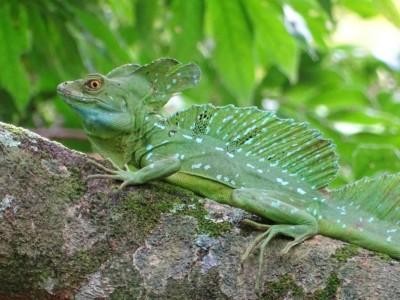January 12, 2022
We are biodiversity
Biodiversity has risen to the current sustainability discussions alongside climate change mitigation and climate change adaptation. It is increasingly clear that biodiversity risks are material and relevant to businesses both in developing countries and in the developed world.
In early 2021, The Economics of Biodiversity: The Das Gupta Review underlined our dependence on the natural world, and the fact that we are currently damaging it so that many of the natural systems that sustain life on earth are now on the verge of a breakdown.

Basiliscus Plumifrons in Nicaragua. Photo by MLR Forestal.
Double materiality of biodiversity
The understanding of the double materiality of biodiversity risks is spreading; it is not just sustainability-related impacts on the company that can be material, but also the impacts of a company on the environment, economy, and society. It is increasingly recognized that businesses can have direct and indirect impacts that can harm biodiversity, while at the same time they are inherently reliant on nature to produce their businesses and services. Thus, it is understood that especially alongside climate change, the deterioration of biodiversity can also harm businesses.
The double materiality of biodiversity risks is especially important in sectors where the company activities and/or supply chains are dependent on nature. These highly nature-dependent sectors typically include forestry, agriculture, fishery and aquaculture, food and beverages, water utilities, etc.
All of these are of importance to Finnfund, as 22% of our portfolio is in forestry and 9 % in agriculture alone. In these sectors management of biodiversity risks is especially important to foster the sustainability of the businesses in the long term.
We are running out of space
Biodiversity risks have also become important in other sectors, where dependence on nature is less evident.
As David Attenborough portrayed in the documentary A life on Our Planet (2020), we are running out of space. Most parts of Earth’s surface have already been modified by human influence, and natural wilderness areas are harder and harder to find (interesting data on this for example in Mapping the extent of human impact on the Earth’s surface | World Economic Forum (weforum.org), UNEP Helping companies avoid damage to natural habitats, and Global Forest Watch). Population growth, expansion of the agricultural frontiers, etc. are pushing nature into an ever-diminishing space, which combined with other factors drives biodiversity loss. Thus, the number of endangered species is increasing (IUCN Red List of Threatened Species, IUCN Red List of Ecosystems).
As biodiversity features such as endangered species, and vulnerable ecosystems are increasingly threatened, the need for effective biodiversity risk assessments and management of biodiversity risks is likely to increase in Finnfund projects across all our sectors.
At the same time, to effectively tackle the challenges of population growth and increased demand for resources in developing countries, the key question related to conserving and protecting biodiversity is how to use more effectively already modified areas so that natural areas can remain as they are. In other words: How to get more output out of the same hectares? In order to meet the need for increasingly efficient land use and resource use we need innovations and modern but nature-friendly solutions.
How does Finnfund manage biodiversity risks?
Finnfund has assessed biodiversity risks of its investments since the first Finnfund Environmental and Social (E&S) Policy was published in 2005. This first E&S policy adhered to World Bank Environmental and Social Safeguards, but was soon updated to include a commitment to the IFC Performance Standards (PS) when the framework was first launched in 2006. The current Finnfund Sustainability Policy 2020 and Climate and Energy Statement 2021 include our current biodiversity commitments.
In addition to compliance with local laws and environmental regulation, Finnfund requires all investees to comply with the requirements of the IFC PS 6 on Biodiversity Conservation and Sustainable Management of Living Natural Resources (2012). The requirements of this performance standard are guided by the UN Convention on Biological Diversity. It recognizes that protecting and conserving biodiversity, maintaining ecosystem services, and managing living natural resources adequately are fundamental to sustainable development, and sets global thresholds and principles for biodiversity management.
In 2020, we assessed that approximately 20% of our investments triggered IFC PS 6 hence there are biodiversity risks or impacts that need to be actively managed by the investees.
In addition, PS1 and PS3 contain biodiversity-related requirements on assessing impacts and risks as well as managing pollution and resource efficiency. These are also linked to the PS 6 requirements.
The more sensitive the environment, the stricter the requirements
The PS 6 requirements apply to all projects in modified and natural environments, projects that impact ecosystem services that are in direct management control of the investee, and projects that include of living natural resources (such as forestry and agriculture). Application of mitigation hierarchy is required to avoid, minimize and restore impacts on biodiversity in project design and during operations. Biodiversity offsets are required (allowed) in case despite all efforts there are residual impacts that could not be minimized or avoided.
There is a very simple logic: The more sensitive the environment, the more stringent the requirements. This approach favours project development in environments that have already been modified by human activities, while the requirements set for projects that would take place in natural unmodified or especially sensitive environments are very rigorous.
The PS 6 denominates these modified, natural, and critical habitats. In modified habitats, projects can be developed with fairly basic biodiversity assessments and monitoring. In natural habitats, projects need to demonstrate no-net-loss to biodiversity, and in critical habitats – for example areas important to endangered species or threatened ecosystems – demonstration of net-gains to key biodiversity values is required.
Biodiversity conservation is risk management
Demonstrating no-net-loss and net-gains is not easy, and it usually requires participation of local and international biodiversity specialists, development of baseline studies, and long-term state-of-the-art management and monitoring plans. The analysis needed moves beyond single species to landscape and ecosystem levels. This work requires time and dedication from both our environmental and social advisers and the personnel of our investees.
In the short term, developing biodiversity management adds to the project development and operation costs of Finnfund investees. Sadly, for some companies the requirements can be too demanding or associated costs can be too high, so financing cannot be granted. However, we believe that fulfilling biodiversity requirements contributes to knowledge transfer and learning, as well as positive biodiversity impacts and conservation outcomes beyond simple risk management. At best the long-term positive impacts spread beyond the company operations to the surrounding landscape and ecosystems.
How does Finnfund compare to peers in biodiversity management?
In May 2021, WWF published a report on Public Development Banks and Biodiversity. The report explores how public development banks are incorporating biodiversity risks into their decision-making and reducing harm to biodiversity.
In this peer comparison Finnfund places among the entities that have solid biodiversity requirements and processes in place to avoid risks and reduce harm, whereas some entities still rely solely on national environmental impact assessments, which in several developing countries are likely to fall well short of international good practice for managing biodiversity risks.
The report recognizes that the application of biodiversity safeguards such as the IFC PS is challenging, and that integrating biodiversity matters in strategic project planning would be ideal to tackle biodiversity risks more effectively – the earlier we are involved in a prospective investment, the better chance we have in helping to avoid and minimize the biodiversity impacts.
Biodiversity Positive Investments – from risk management to finding opportunities?
The WWF report also calls for scaling up nature-positive investments. It points out that Nature-based Solutions (NbS) – a sub-set of climate finance – presents probably the largest opportunity for nature-positive finance for development banks. Nature-based Solutions can seem hard to define, but for example, the recent IUCN Global Standard for NbS sets clear criteria for NbS. The basic idea in NbS is to work with nature to address societal challenges and provide benefits for both human well-being and biodiversity.
In practice, this means finding ways to work with ecosystems, rather than relying solely on conventional engineered solutions – and as a result, this approach helps communities adapt to climate change impacts and benefit biodiversity too (a somewhat similar concept Natural Climate Solutions NCS emphasizes actions that avoid greenhouse gases).
Finding and designing NbS and finding nature-positive investments is the next level in our biodiversity work, as it goes well beyond the traditional biodiversity risk management. Larger players in development financing have already established in-house think tanks and facilities to develop specific nature-finance vehicles (such as EIB Natural Capital Financing Facility, IADB Natural Capital Lab, Dutch Fund for Climate Development).
We have set as our target that in all investments that require adaptation or biodiversity protection or promotion, nature-based solutions are sought and prioritised. By this commitment we challenge ourselves, and our present and future investee companies to take the biodiversity thinking and execution to the next level.
We believe there is a niche for a small and agile and skilled collaborator in nature-positive investments. Let’s work on this together.
Seela Sinisalo
Senior Environmental and Social Adviser
Read more
Capturing adaptation opportunities – Finnfund
Support to smallholder tree farming relieves the pressure on natural forests in Africa – Finnfund
